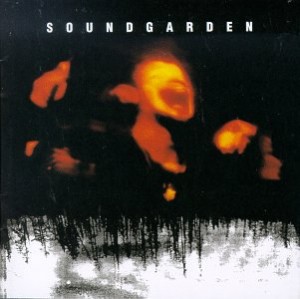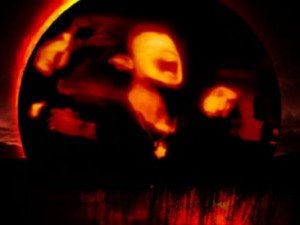Whenever a big record anniversary pops up, I find multitudes of friends and acquaintances scratching their heads wondering where the time went. Then they remind themselves of college loans, mortgages, car payments, insurance, kids, and that window of lost time opens wide. The record that will surely bring on these existential questions is Soundgarden’s Superunknown, celebrating its twentieth year among us.
 In a sense, Soundgarden was the “Zelig” of its scene. The band came up through Sub Pop Records alongside Nirvana and Mudhoney. They hung in the same circle as did Mother Love Bone, half of which would become Pearl Jam after the death of that band’s lead singer Andrew Wood. Superunknown was produced by Michael Beinhorn who had previously produced records for Red Hot Chili Peppers, Violent Femmes and Soul Asylum. Perhaps more emblematic, the album was mixed by Brendan O’ Brien who would become ’90s rock’s go-to producer. Both Pearl Jam and Stone Temple Pilots were adopting him as their official/unofficial member throughout that decade.
In a sense, Soundgarden was the “Zelig” of its scene. The band came up through Sub Pop Records alongside Nirvana and Mudhoney. They hung in the same circle as did Mother Love Bone, half of which would become Pearl Jam after the death of that band’s lead singer Andrew Wood. Superunknown was produced by Michael Beinhorn who had previously produced records for Red Hot Chili Peppers, Violent Femmes and Soul Asylum. Perhaps more emblematic, the album was mixed by Brendan O’ Brien who would become ’90s rock’s go-to producer. Both Pearl Jam and Stone Temple Pilots were adopting him as their official/unofficial member throughout that decade.
Up until its release, the band had been seen as a mid-strata player. Many of their contemporaries were being taken into the new mainstream with welcoming arms. Badmotorfinger had its moment on MTV’s 120 Minutes,specifically with the track “Jesus Christ Pose.” I hesitate to say that the track “Rusty Cage,” while seeming to be influential now, probably wasn’t nearly as recognized as it was after Johnny Cash covered it, but I don’t have the data to support the assertion. Nevertheless, with that record there was a feeling that Soundgarden would stay comfortably ensconced within the confines of a thousand wanna-be new bands plugging into their dad’s attic-abandoned amps, bumping up against older bands from the ’70s and ’80s who suddenly gruffed-up their sound to fit in.
Then the flats started appearing in the stores. More explanation: a “flat” is a full-sized replica of a vinyl album cover’s front, distributed to stores to advertise new and current releases. The strange part about that is, by this time, the CD had temporarily put vinyl records in the grave, so this image on this 12-inch square was rather anachronistic. Yet, as record buyers would come to find, you probably couldn’t have come up with a better way of packaging Superunknown. Take the image; that upside-down forest, bleak and rendered almost is if it was hand-drawn with a Rapidograph pen. It occupies the lower third of the cover. In the middle, the expanse of the darkened woods, there are howling faces lit as orange, nearly appearing as rising flames, depending on your vision capability. At the top, as if it was a debut, was just the band’s name in white, reintroducing itself to the world.
All the records from this era, no matter what bucket we contrive for them, are rock records. In hindsight, it’s easier to see than back in that time when the terms “grunge” and “alternative” were being slapped upside everyone’s heads. The influences couldn’t be more apparent now, with Nirvana’s meshing of punk energy and pop construction, Pearl Jam kneeling at the altars of Neil Young and Crazy Horse as well as The Who, and Alice In Chains’ downtuned dirges paying respects to Black Sabbath. For Soundgarden, one could say their forefathers were Led Zeppelin, though I’d probably put Cactus above them on the list. Either way, it’s difficult to hear, “Alive in the superunknown/first it steals your mind and then it steals your…soul” and not vaguely recall Robert Plant’s trailing howl.
The reason for the advent of the “grunge” term was two-fold. First, pop culture hates to admit that things have circled back around in any way. The idea that ’70s hard rock and punk had somehow come back into style was abhorrent, especially considering the bleak mindset of many of the new artists. It seemed to smack in the face of the ’70s hedonism, with “Babe I’m gonna screw you” being replaced by “We’re all screwed.” Grunge as a catch-all indicated this was, at least in small ways, a new thing, which is a highly marketable commodity at all times. The second reason why the “grunge” moniker caught on was because parents of the young adults who liked this music were raised on rock music. There was something really unpalatable about sharing this — or anything — with the parents. What a sad state of rebellion!
 With all of that now laid out on the table, one sees Superunknown as the most reverent of this least reverent musical movement. There’s no question that this is a classic rock album in the sheep’s clothing of a new, scary malcontent. Even the record’s biggest hit, the woozy “Black Hole Sun”, is more-accurately identified as a psychedelic song. If a teen or twenty-something attempted to connect with their hard-rock-loving, formerly-hard-partying parents, this album was the way to do it. Most of the tracks are easily sung along to. “My Wave” has that mantra-like “Keep it off my wave, keep it off my wave, keep it off my wave, my wave”. “Fell On Black Days” could have been Bad Company at its grumpiest.
With all of that now laid out on the table, one sees Superunknown as the most reverent of this least reverent musical movement. There’s no question that this is a classic rock album in the sheep’s clothing of a new, scary malcontent. Even the record’s biggest hit, the woozy “Black Hole Sun”, is more-accurately identified as a psychedelic song. If a teen or twenty-something attempted to connect with their hard-rock-loving, formerly-hard-partying parents, this album was the way to do it. Most of the tracks are easily sung along to. “My Wave” has that mantra-like “Keep it off my wave, keep it off my wave, keep it off my wave, my wave”. “Fell On Black Days” could have been Bad Company at its grumpiest.
There were tons — literal tons — of albums that came out during the span of 1991-to-1997, when the blush had truly fallen off the whole alternative superstructure. Every major record label had mined the indies looking for the next big thing. Then rap and hip hop found a revitalized life on the pop music scene, electronic music started to surge forward with the likes of Moby and The Orb, and alternative music started to sound rather quaint again. Nirvana ended, as we all know, after Kurt Cobain’s suicide. A lot of the bands that survived started putting out records that felt like missteps, or were merely perceived as missteps, because the audience was moving on. Pearl Jam was becoming an institution, and more like U2 and REM than a bunch of snarling Seattle-ites (with a California transplant). Smashing Pumpkins went electronic/trip hop, then industrial, then kaput. (I leave it up to your personal inclinations to decide whether they’re “back” or still “kaput”.) After the release of Down On The Upside in 1996, Soundgarden called it quits too. They have since reformed.
It came as no surprise that the album did so well and still endures alongside other well-known records from the era. Superunknown embraces its affinities rather than wearing them inside out. Universal has re-released the album to honor the occasion of the 20th anniversary, but I have not heard it. In multiple configurations, the purchases are all overpriced. I’m sure the added material is plentiful and the sound is pretty good (although the original never suffered from the faults of early CD mastering), but it is hard to buy into a two-record set of a twenty year old title that goes for $60.
Nonetheless, my original copy sits comfortably in my stack of hard rock albums, and doesn’t seem remotely out of place in the playlist. Superunknown wasn’t the record that sparked new musical movements. It wasn’t any voice of a generation. I doubt it changed lives, as so many other recordings claim, much as I doubt those other recordings changed anything either. It was a soundtrack of the times that almost lovingly, not insultingly, paid tribute to a time before. It still sounds pretty good when played very loudly. For a rock album, there are few better things to be than that.





Comments